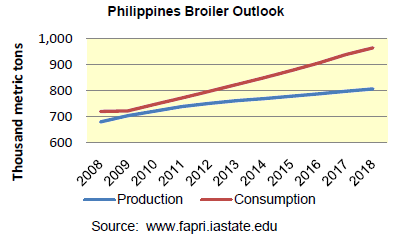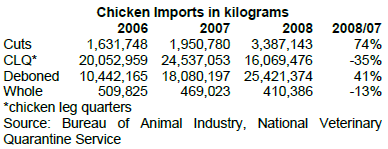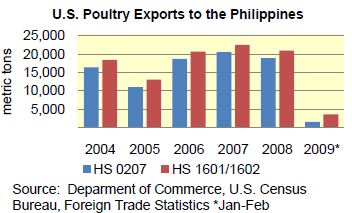



International Egg and Poultry Review
US - By the USDA's Agricultural Marketing Service (AMS). This is a weekly report looking at international developments concerning the poultry industry. This week's report is about the poultry situation in the Philippines.Philippines
The Philippines poultry sector was valued at about P131 billion ($2.7 billion) in 2008, 11 per cent higher than in 2007. Poultry production represented 14.11 per cent of total agricultural production in the country. Chicken production was the primary source of growth in the subsector, and grew 5.76 per cent to total P98 billion ($2 billion) in value. According to the Philippine Department of Agriculture’s (DA) Bureau of Agricultural Statistics (BAS) one factor contributing to the growth in 2008 was the rehabilitation of typhoon damaged farms in Ilocos Region in Luzon. In the fourth quarter there were reports of new commercial in broiler farms in Ilocos Norte and an in increase in the number of contract farms in Northern Mindanao.

Chicken meat production grew from 1,211.6 thousand metric tons (TMT) live weight in 2007 to 1,281.4 TMT in 2008. Rising feed and production costs combined with possible weaker consumer demand will constrain growth in 2009. Duck production fell from 42.5 TMT in 2007 to 39.2 TMT in 2008.

Broiler consumption is expected to continue to exceed domestic production. The Philippines imported 45,772 metric tons in 2008, mostly deboned chicken followed by chicken leg quarters. Canada was the top importer (17,122 MT), followed by the US (13,743 MT), Brazil (8,216 MT), and Australia (5,477 MT).


The majority of all the country’s chicken meat imports (except mechanically deboned or separated poultry) fall under MAV (Minimum Access Volumes). In June 2007 the Philippines lowered the tariff on mechanically deboned meat (MDM) of chicken and mechanically separated turkey (MST) to 5 per cent exempt from MAV as a result of concessions granted. Prior to this exemption, about 40 per cent of all poultry imported under MAV was made up of MDM or MST. The MAV utilization rate fell from 97 per cent in 2006 to 85% in 2008.
Both in-quota and out-of-quota tariff rates for MAV commodities are 40 per cent. Tariff rates for ASEAN countries have dropped to 20 per cent and are expected to reach 5 per cent in 2010.

The Philippines Department of Agriculture had announced a review of the MAV system in October 2007 but later announced the indefinite postponement of any changes to the system. The uncertainty caused by the MAV review and delays in the issuance of MAV licenses contributed in part to the decline in chicken leg quarter imports in 2008.
Chicken egg production went up 4.67 per cent in 2008. The impressive improvement in egg-laying efficiency ratio of layers boosted the uptrend. About 75 per cent of the total table egg production was produced from commercial layer farms, the balance from native chicken. Duck egg production totaled 42.5 TMT in 2008.
Source: USDA/Foreign Agriculture Service Attaché Reports; Republic of the Philippines Department of Agriculture; US Trade Representative 2009 National Trade Estimate Report

Further Reading
| - | You can view the full report by clicking here. |











